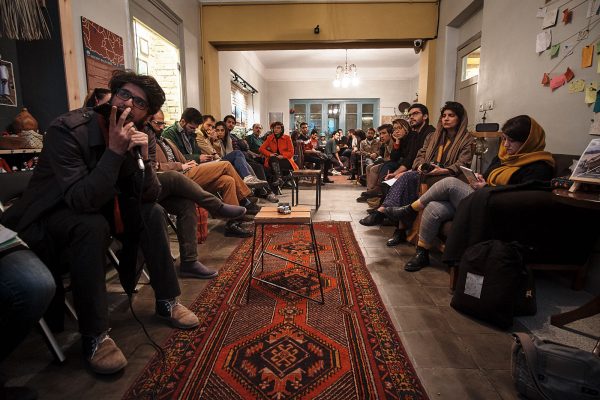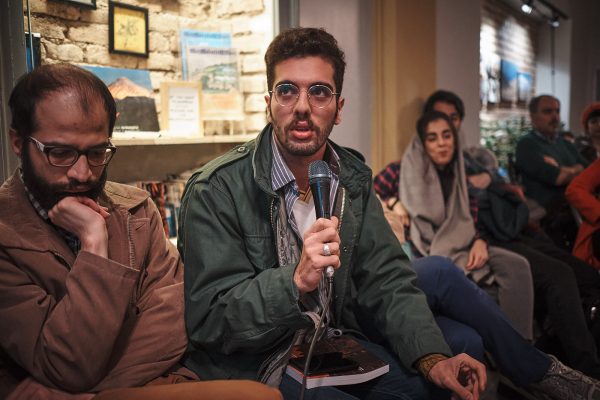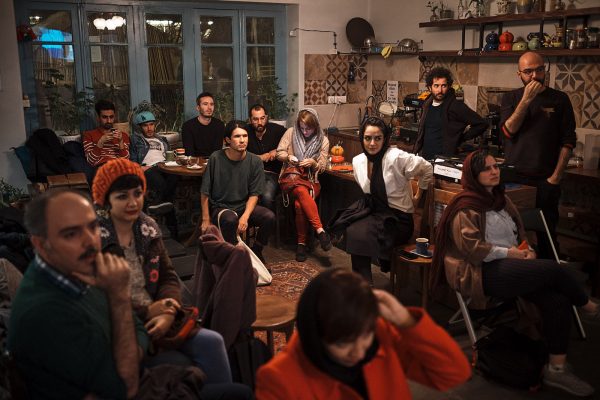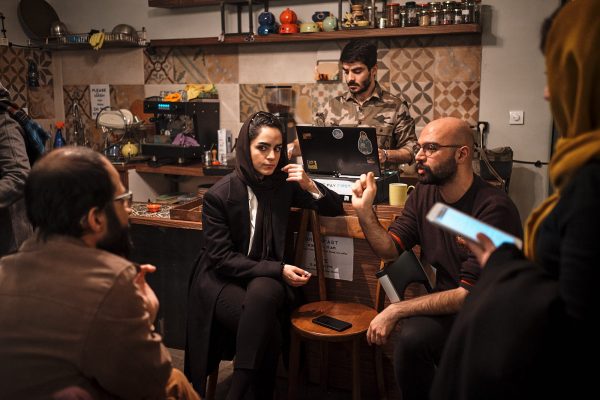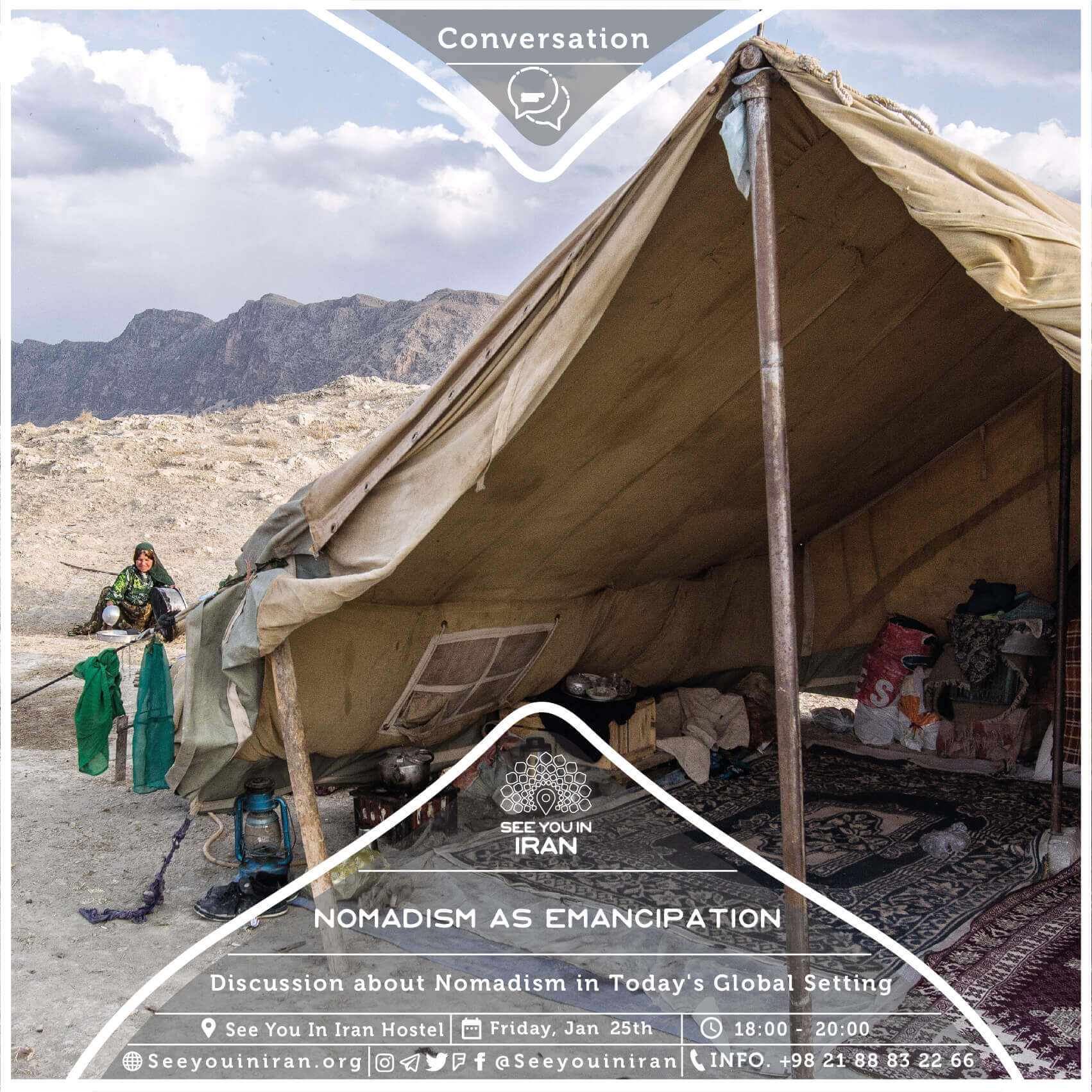Discussion about Nomadism in Today’s Global Setting
Friday, January the 25th at 6:00 pm
Location: See You in Iran Hostel (On the map)
On the sixth night of See You in Iran’s Migration Series, we hosted Pooya Ghoddousi, a lecturer at the University College London (UCL), who shared with us his ideas about nomadism and its potential emancipating role for the modernised human. He attempted to elaborate on how different forms of nomadism can be applicable to today’s societies and its relations to transnational migration referencing to his doctoral thesis in which he has fused his experiences in living with Iranian nomads and his field research about the Iranian transmigrants. As it is customary to most of our events, thereafter a discussion about the proposed ideas took place with the participation of our guests.
Pooya’s target demographic consisted of middling Iranian transmigrants living in London though not limited to it and it expanded to their family, friends and social circles in general. His main objective was to test whether the theories of social science thinkers like Ibn Khaldun, Deleuze and Guattari about nomadism are compatible with transmigrants’ situation. Ibn Khaldun was the first social historian that defined nomadic way of life as an opposite to sedentary or city living. He proposed that the concept “Acabiyah” which means group solidarity is one of the main features that empower nomads in confronting the sedentary societies. Pooya points out that most of the middling Iranian migrants have been successful in pursuing better quality of life but their success has always been limited to a personal level. Delving more into concepts such as acabiyah might give us more insights as to how to unite such communities which convert into momentum in pursuit of incentives that benefit the whole.
Deleuze and Guattari put more emphasis on de-territorialisation tendencies of nomadic societies: “the nomad has no points, paths or land”. Contrary to sedentary societies that idealise hierarchy, borders and walls nomads tend to distance themselves from such confining concepts. Though the sheep and goat herders of the Iranian plateau were part of a dimorphic society and lived in constant “conflict, co-existence” state with their sedentary neighbors, the lines remained clear to them. One of the participants mentioned that hierarchy is still present within the nomadic tribes of Iran. Hierarchy becomes critical within the nomadic structure when they need to negotiate or demand something from the centralized power. How can this be related to Iranian migrants, one of our guests asked. The sedentary way of existence embodies self-other discourse that stems from capital accumulation and power monopolization beside other components. The self-other dichotomy is apparent within Iranian migrants’ communities. Replicating the nomadic de-territorialisation approach the community can form the hierarchy when it comes to social and other types of demands that require unity of large numbers and reform afterwards.
In analyzing the middling Iranian transmigrants, Pooya concludes that just like dimorphic societies, the narrative of this group about the sense of social belonging and identity forms a dialectic between being a nomad and a settler. Now he is aiming to figure out how by creating a balance in this dialectic in a broad scale we can approach an equitable development.
در شب ششم از سری رویدادهای مهاجرت میزبان پویا قدوسی، مدرس University College London، بودیم تا درباره کوچندگی و امکان بهرهمندی انسان مدرن از این سبک در زندگی امروزی برای مهمانان خانه فرهنگی See You in Iran برایمان توضیح دهد. او با استفاده از محتوای پایاننامه دکترای خود به تفکیک انواع زندگی نومدیسم و بررسی وجوه تشابه آن با مهاجران ایرانی مقیم لندن که عدم وجود حس تعلق اجتماعی در آنها باعث بلاتکلیف بودن زندگیشان میشود پرداخت. پویا از تجربه زندگی با عشایر ایران و تحقیقات میدانی از مهاجران مقیم لندن نیز برای نوشتن پایان نامه خود استفاده کرده است. پس از ارائه نظرات پویا در کنار حاضرین در رویداد به تبادل نظر در مورد شیوه زندگی نومدیسم و اینکه آیا اساسا میتوان از تئوریهای موجود در این زمینه برای حرکت به سمت توسعه عدالت محور بهره گرفت یا خیر پرداختیم.
جامعه هدف پویا در تحقیقاتش ایرانیان مهاجر ترامرزی طبقه متوسط، خانواده و معاشرین این گروه است. او با کندوکاو در نظریههای مرتبط با کوچندگی دانشمندان علوم اجتماعی و فلاسفه مانند ابن خلدون، دلوز و گوتاری در پی توصیف و بهبود شرایط این گروه از مهاجران است. ابن خلدون اولین مورخ و اندیشمند علوم اجتماعی است که کوچندگی را به عنوان یک سبک زندگی در مقابل یکجانشینی و زندگی شهری قرار میدهد. نومدیسم و یکجانشینی در جوامع دوشکلی همواره در طول تاریخ با یکدیگر در حال تعامل و تقابل بودهاند و این دیالکتیک تا حد زیادی وابسته به ثبات در جامعه است. ابن خلدون به عاملی توانمندساز در میان مردمان نومد اشاره میکند که به آن “عصبیت” میگوید. عصبیت مفهومیست بر مبنای برابری و همدلی که شیوه اداره اینگونه قبایل را نیز افقی ترسیم میکند. این مفهوم در طول تاریخ جوامع نومد را در هنگام تقابل با یکجانشینها قدرتمند ساخته و حس اتحاد را در میان آنها تقویت کرده است. یکی از مهمانان اشاره به عدم وجود همچین حسی در بین مهاجران ایرانی کرد که پویا در تصدیق این امر گفت: مهاجران ایرانی غالبا در رسیدن به اهداف خود از مهاجرت، تحصیلی و شغلی، در سطح فردی موفق بودهاند اما همافزایی این دستاوردها برای کنشهای اجتماعی که از منافع ایرانیان در سطح کلان حمایت کند ضروری است. همافزایی که در برخی موارد مانند مسدود شدن حساب ایرانیان خارج از کشور میسر شده اما این اتحاد در حد قابل توجهی تحت تاثیر هویت ایرانی و خوانش از هویت نیز تحت تاثیر شرایط بلاتکلیفی مهاجرین است. مفهوم عصبیت در این نقطه برای ارائه راه حل از نظر پویا اهمیت پیدا میکند و میتوان با استفاده از آن برای اتحاد این گروه از مهاجرین به شیوه اجتماعات نومد تلاش کرد.
دلوز و گوتاری مفهوم دیگری را از اینگونه اجتماعات استخراج کرده و برای مطالعه آنها مورد تاکید قرار میدهند که تحت عنوان “قلمروزدایی” از آن نام میبرند: “کوچندگان هیچ مسیر، زمین و نقطهای ندارند”. نومدها برخلاف جوامع یکجانشین که در آنها سلسلهمراتب، دیوار و مرز ارزشمند میشوند، از این عناصر گریزانند. گله داران کوچنده فلات ایران از دیرباز با همسایگان یکجانشین خود در همزیستی- تقابل به سر بردهاند. این همزیستی به نفع کل جامعه دوشکلی بوده است اما گرایش نومدها به قلمروزدایی و پس زدن سلسله مراتب مانع حل شدن آنها در سبک زندگی یکجانشینی شدهاست.در جواب اشاره یکی از حاضرین به این نکته که سلسلهمراتب در بین قبایل کوچنده ایران امری مرسوم بوده و همچنان وجود دارد پویا میگوید در مواقعی که مواجه با یکجانشینان ضروریست این سلسلهمراتب بوجود میآیند در غیر این صورت نومدها تمایلی به اینگونه سازوکارها ندارند. در جوامع شهرنشین امروزی انباشت سرمایه و تمرکز قدرت باعث بوجود آمدن گفتمان خود-دیگری و در واقع از بین رفتن عصبیت میشود. با ایده گرفتن از قلمرو زدایی که حس تعلق اجتماعی را محدود به مرزبندی نمیداند و عدم انباشت سرمایه و قدرت امری ضروری میپندارد میتوان ساختارهای پایدارتری برای پیگیری مطالبات جمعیت مهاجرین ایرانی بینابینی بوجود آورد.
در تحلیل جامعه بینابینی مهاجران ایرانی پویا به این نتیجه میرسد که همانند جوامع دوشکلی رفتار این گروه و تک تک افراد تعامل و تقابلی میان شیوه نومد و یکجانشینی است. او با ادامه تحقیقات خود در این زمینه قصد دارد با تلفیق این شیوههای زندگی در بستر جوامع امروزی راهی برای توسعه عدالت محور بیابد.
Nomadism, in its different forms (hunter-gatherers, pastoral nomads and Roma or peripatetic nomads), has been one of the humankind’s oldest ways of living. Considering the fact that human lifestyle is currently influenced by modernism and borders, nomadism still exists though the ratio to sedentary (not moving) societies has decreased. During the sixth night of See You in Iran’s migration event series we intend to answer the below questions with the presence of Pooya Ghoddousi, a lecturer at the University College London (UCL).
Is there still room for nomadism in today’s world?
Beside traditional forms of nomadism (hunter-gatherers, pastoral nomads and Roma or peripatetic nomads) can we find new forms of it among global migrants?
Do traditional ways of nomadism still have lessons for our current condition?
Pooya Ghoddusi is a Teaching Fellow in Global Migration whose thesis is titled “Dimorphic diasporas: Assembling identity, community belonging, and collective action among Iranians in London”. The focus of the thesis is on the applicability of nomadism in today’s societies and its relations to transnational migration. Pooya has fused his experiences in living with Iranian nomads and his field research about the Iranian transmigrants to finalise the study
If you are interested to participate in this event, join us at 6:00 PM on Friday, January 25 th, at See You in Iran Cultural House
Photo by: Sardar Farrokhi from the Photo Essay: “Obscured Journey”
th at 6:00 pm.
نومدیسم یا کوچندگی در اشکال گوناگون آن (شکارچی – گردآورنده، عشایر دامدار و روما دوره گرد) از قدیمیترین شیوههای زیست بشر است. گرچه در دنیای امروز که سبک زندگی انسان تا حد قابل توجهی متاثر از مدرنیسم و محدود به مرزبندیهاست، نومدیسم همچنان به بقا ادامه میدهد اما نسبت جمعیت کوچندگان به یکجانشینان تقلیل یافته است. خانه فرهنگی See You in Iran در شب ششم از سری رویدادهای مهاجرت به موضوع نومدیسم خواهد پرداخت. قصد داریم در این برنامه با حضور پویا قدوسی، مدرس University College London درباره سوالات زیر گفتگو کنیم.
آیا به غیر از شیوههای پیش گفته نومدیسم (شکارچی – گردآورنده، عشایر دامدار و روما دوره گرد) میتوان انواع جدیدی را نیز در بین مهاجران جهانی یافت؟
آیا نومدیسم فقط به معنای جابجایی فیزیکی یا کوچ از یک مکان به مکانی دیگر است؟
آیا شیوه های سنتی نومدیسم هنوز درسهایی برای کمک به وضعیت امروز ما دارند؟
پویا قدوسی دکترای خود را در رشته جغرافیای انسانی با موضوع «دیاسپورای دوشکلی: شکلگیری هویت، حس تعلق و کنش جمعی میان ایرانیان لندن» گرفته است. این رساله در مورد شیوههای نوین نومدیسم در دنیای امروز است. در این پژوهش پویا با تلفیق تجربیات شخصی خود در زندگی با عشایر ایران و سپس انجام مطالعات میدانی درباره ایرانیان فرامرزی کوشیده است خوانشی جدید از مهاجرت ایرانیان ارائه کند.
اگر علاقمند به حضور در این رویداد هستید از شما دعوت میکنیم روز جمعه پنجم بهمن ساعت ۶ عصر درخانه فرهنگی See You in Iran در کنار ما باشید.
عکس از مجموعهی «سفر ناشناخته» از سردار فرخی

